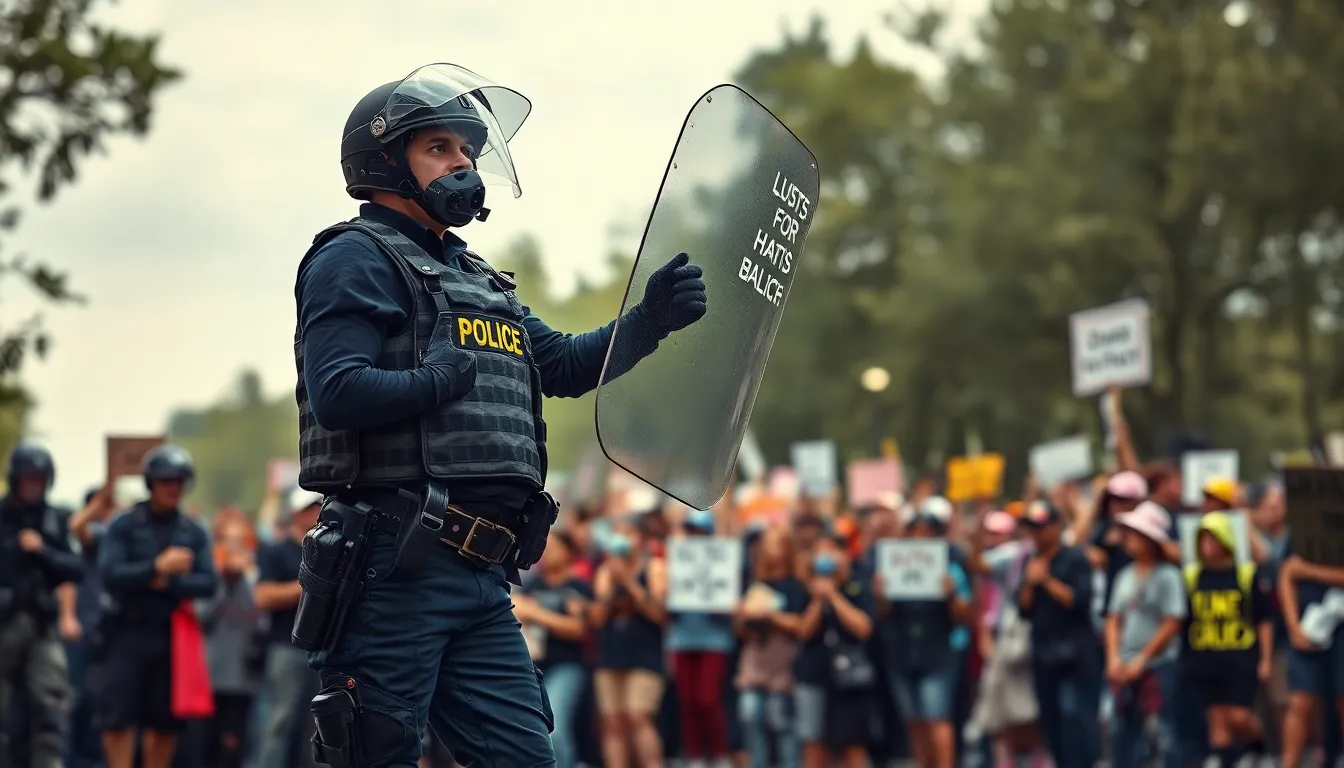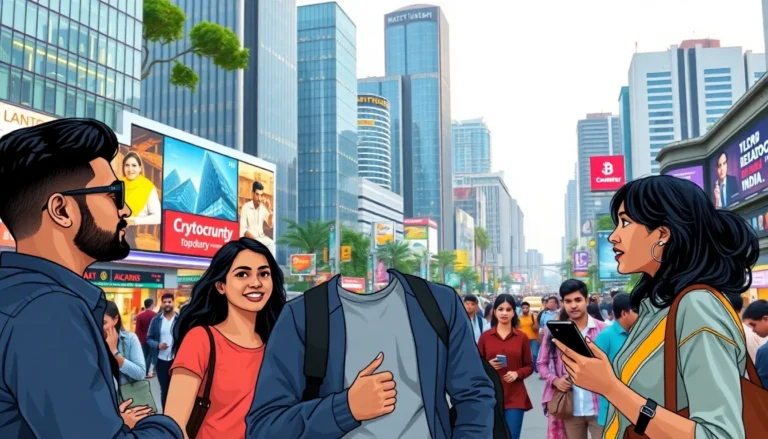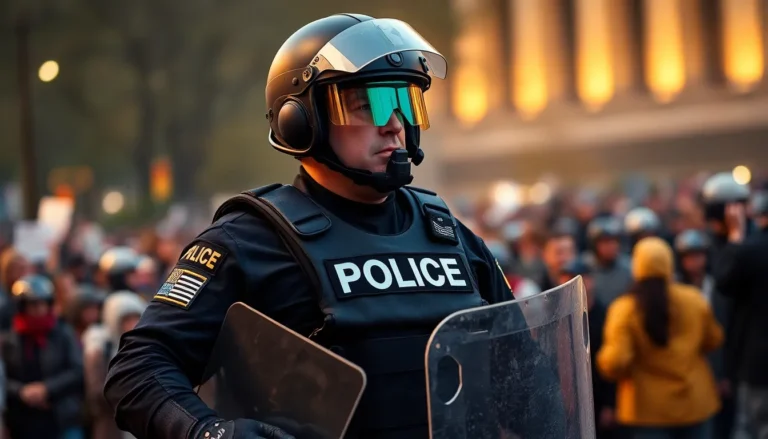When the streets heat up and tensions rise, police riot gear steps into the spotlight, transforming ordinary officers into modern-day knights. With helmets that could make a medieval warrior jealous and shields that could stop a charging bull, this gear isn’t just for show. It’s designed to protect and serve, ensuring safety for both officers and the communities they patrol.
But let’s be real—who doesn’t find a fully armored officer a tad intimidating? From the iconic batons to the latest in protective technology, police riot gear combines functionality with a touch of flair. It’s not just about looking tough; it’s about maintaining order while keeping everyone safe. Dive into the world of police riot gear and discover how these tools are more than just fashion statements—they’re essential for peacekeeping in chaotic times.
Table of Contents
ToggleOverview Of Police Riot Gear
Police riot gear consists of specialized equipment designed for crowd control and safety during civil disturbances. This gear includes various protective items tailored to help officers maintain order while minimizing harm.
Definition And Purpose
Police riot gear encompasses protective clothing, shields, helmets, and non-lethal weaponry. These items shield officers from potential projectiles and physical confrontations. The primary purpose remains to ensure officer safety while deterring violence in high-stress situations. Items like body armor offer crucial protection against impacts, while helmets prevent head injuries during protests. Non-lethal options, including rubber bullets and tear gas, facilitate crowd management without escalating violence.
Historical Context
The use of police riot gear originates from the need to control large crowds during protests and civil unrest. Notable events in the 1960s, such as the civil rights demonstrations, led to increased reliance on specialized equipment for public safety. Development progressed in the 1980s, with modern materials enhancing protective gear’s effectiveness. Later, incidents like the 1992 Los Angeles riots prompted further refinement of equipment standards. Today, police agencies worldwide adopt advanced technology to ensure readiness for diverse scenarios while maintaining public trust.
Types Of Police Riot Gear

Police riot gear includes various specialized equipment aimed at ensuring safety and control during civil disturbances. Understanding these types aids in appreciating their roles in maintaining order.
Personal Protective Equipment
Personal protective equipment (PPE) encompasses items designed to shield officers from harm. Officers typically wear reinforced vests to guard against projectiles. Additionally, helmets often feature visors that protect against impacts and projectiles. These helmets are crucial for maintaining visibility while ensuring safety. Gloves offer protection during encounters, minimizing the risk of injury. Steel-toed boots provide support and safeguard feet in unpredictable situations. Each piece of PPE contributes to an officer’s ability to respond effectively while minimizing personal risk.
Crowd Control Tools
Crowd control tools play a vital role in managing large gatherings during protests. Officers use shields to create barriers between themselves and potentially hostile crowds. Such shields absorb impacts while allowing personnel to advance safely. Tear gas serves as a non-lethal option for dispersing unruly crowds, creating a safe exit route. Additionally, batons allow officers to maintain distance while managing aggressive behavior. Each tool is strategically used to de-escalate conflict while promoting public safety.
Effectiveness Of Police Riot Gear
Police riot gear enhances safety during civil disturbances, allowing officers to perform their duties more effectively. This specialized equipment provides crucial protection and operational functionality.
Advantages
Advanced protection is one advantage of police riot gear. Reinforced vests withstand impacts, while helmets shield against projectiles. Shields offer additional defense during confrontations, enabling officers to maintain their positions. Non-lethal weapons, like tear gas and rubber bullets, help control crowds with reduced risk of severe injury. Increased visibility and identification also serve an important role; officers become recognizable figures in the chaos, promoting authority and order. Overall, this gear promotes confidence among officers, which is essential for maintaining peace during volatile situations.
Disadvantages
Despite its benefits, police riot gear has drawbacks. Weight can hinder mobility, making quick responses more challenging. Additionally, the intimidating appearance may escalate tensions with civilians, leading to public backlash. High costs associated with purchasing and maintaining this gear can strain police budgets. Limited effectiveness against determined rioters poses another issue; no gear guarantees safety in all scenarios. Training in proper use must align with available equipment, and lack of adequate training may lead to misuse. Balancing safety and public perception remains a complex hurdle for law enforcement agencies.
Controversies Surrounding Police Riot Gear
Police riot gear sparks significant debate among various stakeholders. Discussions often center on its impact on public perception and the legal implications surrounding its use.
Public Perception
The presence of riot gear can influence public opinion about law enforcement. Many view it as a sign of preparedness, providing reassurance during volatile events. Conversely, some perceive such gear as militarization of the police, leading to increased distrust. Polls indicate that communities exposed to heavy police presence during protests often report feelings of intimidation and alienation. The gear’s appearance can exacerbate tensions rather than foster a sense of security. Striking a balance between visibility and approachability is critical for maintaining community relations.
Legal Implications
Legal frameworks governing the use of police riot gear vary across jurisdictions. Officers must adhere to specific guidelines to ensure compliance with constitutional rights. Courts have ruled on cases where aggressive deployment of riot gear prompted claims of excessive force. These legal precedents highlight the importance of proper usage to avoid liability. Policymakers face pressure to balance the need for safety with protecting civil liberties. Regulations typically mandate training for officers on the appropriate use of gear, ensuring that rights are respected during operations.
Future Trends In Police Riot Gear
Future trends in police riot gear focus on evolving technology and policy shifts. Law enforcement agencies increasingly prioritize gear that enhances officer safety and community relations.
Technological Advancements
Advancements in technology drive significant improvements in police riot gear performance. Smart helmet systems now include augmented reality features, enabling officers to access real-time information during incidents. Enhanced body armor utilizes lightweight materials, offering increased mobility without sacrificing protection. Wearable cameras capture interactions, promoting accountability and transparency. Additionally, non-lethal weaponry is evolving to minimize harm, with options like advanced tasers and foam projectiles becoming more common. These developments aim to assist officers in managing aggressive crowds while prioritizing safety for both police and civilians.
Changes In Policy
Changes in policy reflect growing concerns about police transparency and community engagement. Many departments are adopting stricter guidelines governing the use of riot gear during protests and public gatherings. Policies promote the principle of proportionality, ensuring that officers use only necessary force in response to specific situations. These adaptations encourage a focus on de-escalation tactics, fostering better relationships between law enforcement and communities. Increasingly, law enforcement agencies emphasize training in conflict resolution and community interaction, aligning with public expectations for safety and civil rights.
Police riot gear plays a pivotal role in maintaining order during civil disturbances. Its evolution reflects the ongoing need for effective crowd management while balancing officer safety and community trust. As technology advances and policies adapt, the focus shifts toward enhancing accountability and fostering positive relationships between law enforcement and the public.
The ongoing dialogue surrounding the use of riot gear highlights the necessity for transparency and adherence to constitutional rights. By prioritizing training in conflict resolution and community engagement, police agencies can better navigate the complexities of modern policing. This approach not only ensures safety but also promotes a more harmonious relationship with the communities they serve.








